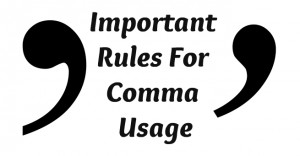Important Rules For Comma Usage

Commas are very important when it comes to proper spelling and writing a sentence to make sure it reads fluidly. Not knowing when to use a comma can end up making the person reading your writing to become confused. Here are some very important rules for comma usage from Online Spellcheck.
What is a Comma?
Just in case you want to know what a comma is then it is very simple; a comma is a ‘Soft stop’ which allows you to tell the reader to pause for a moment. When found in long sentences, commas are used to separate clauses. This allows the reader to understand exactly what modifiers end up applying to which words and so on.
Think grammar is not important? Then check out Reasons Why Grammar and Spelling Matters
Commas separate nouns or ideas and change a noun to a verb. You can use a comma to separate between coordinate objectives. In this sentence “In order to get home, we must travel over numerous winding, narrow, dangerous roads” we find the commas are used correctly. However, in this one “Michael owns various red, big sweaters” the comma is not used properly. Chances are that if you can ad an AND or a BUT between the adjectives, then a comma can most likely go there instead.
The Right Time to Use a Comma
Another time you should use a comma is when you are trying to set off phrases that express variation. Examples such as “It was his wealth, not his wit or charm, that first attracted her” and “The kittens were adorable, but really messy” show us the need to use the comma to demonstrate contrast. You should also use a comma to avoid confusion when writing a sentence. A case in point is found here:
For many the season has already ended.
For many, the season has already ended.
As we can see, the latter sentence correctly separates the words to help the writer avoid confusion to the reader. Whenever you are trying to separate the elements in a series of 3 or more things, a comma needs to be used. This includes the last two.
She took the shirt, washed the jeans, and ironed the skirt.
While to most, the first 2 commas may seem correct, the last one appears wrong. However, there are many instances where a comma needs to be inserted after the word and if the list is lengthy or complex. Often called the Oxford comma or the Serial comma, this last one between the word “And” is often left out by writers; especially in newspapers. Nevertheless, just because they do so, does not mean you should. In another instance a comma should be used is when you need to set off an introductory element such as “While taking a photo of himself, he suddenly realized how silly he looked”
Take a look at The 4 Most Helpful Spelling Rules
When using a little conjunction such as (and, but, nor, yet, or, but, so) to connect 2 independent clauses, a comma needs to be used as well. Example which explains this is found here: “She, hit the nail in the head, but broke the tiles on the floor” This coordinating conjunction is a suitable separation for sentences with a short, balanced individualistic clauses.
There are several other points at which you should use a comma. As you continue to write and get better in your writings and grammatical knowledge, so will your understanding of when and when not to use a comma. Knowing the important rules for comma usage can profoundly impact the style and success of your writings.
